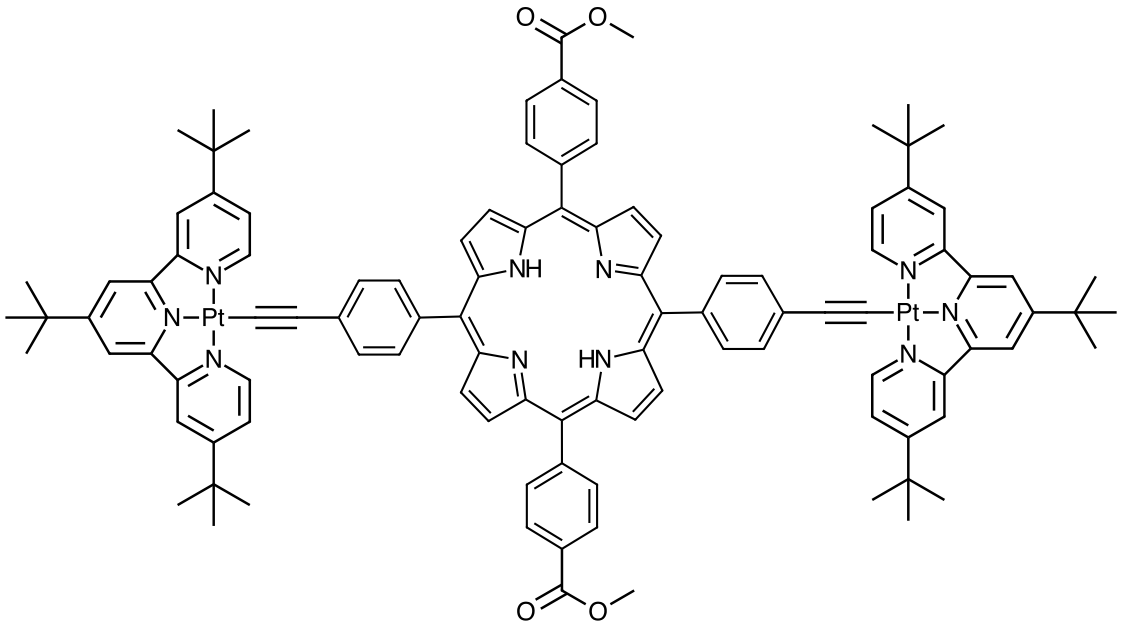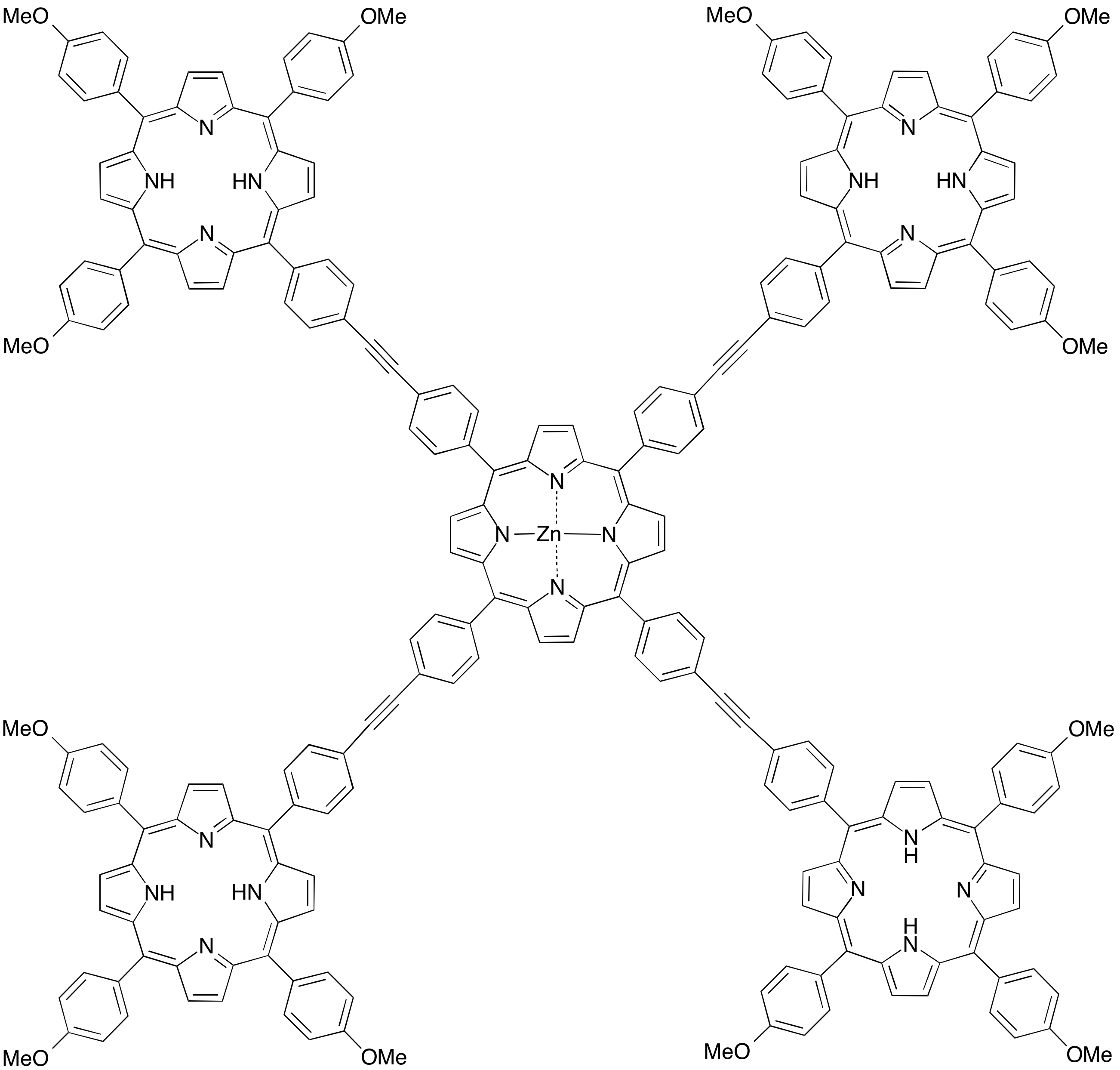58th Annual Report on Research 2013 Under Sponsorship of the ACS Petroleum Research Fund
Reports: UNI1051012-UNI10: Synthesis of New Tunable Porous Coordination Materials to Demonstrate Geared Motion in Solid-State Materials
Stephanie L. Gould, PhD, Austin College
Tunable Molecular Gears in the Solid-State
This ACS PRF funded proposal aims to utilize supramolecular interactions to provide a template for organization and function of geared molecular rotors. The PI originally proposed the creation of a porous coordination material to facilitate the orientation of rotational components to demonstrate gyroscopic and correlated motions in the solid state. These studies are to be done primarily in three-dimensional crystalline aggregates for which no geared motion has been previously reported to-date. The overall proposed structure is illustrated in Figure 1.
Figure 1. Proposed Stacked Rotor, Porphyrins (purple diamonds) are covalently bonded to rotator components (red circles pillared by bidentate ligands (orange ovals).
During the second year of funding from the ACS PRF, two monomers, 1 and 2, have been successfully synthesized and characterized. Purification complications have been overcome. Unfortunately solubility of the final product has presented new challenges. Those new challenges are currently being worked on such that crystallization of molecular rotor systems can be done.
Figure 2. Target Molecules 1 and 2
Unfortunately, very little research was done during the summer 2013 because the PI of this grant was not allowed access to her laboratories from April to August 2013. Access was limited to moving equipment, glassware and chemicals into the new building. The PI discussed this situation with her program officer at the ACS-PRF. Money spent on this project during the 2012/2013 year was limited. A no-cost extension was granted to allow the PI to use her grant money during the upcoming year when the lab will not be moving. Four students (Ashley Hellman, Stephanie Lee, Brian Clinton and Raven Clark) presented their work on this project.[1],[2]
Development of new Dyes for use in Dye-Sensitized Solar Cells
In collaboration with the Dr. Bradley Smucker at Austin College, the PI has been able to utilize the excellent photochromic properties of porphyrins with the luminescent properties of terpyridinyl platinum complexes to form a broad-spectrum dye for use in a dye-sensitized solar cell. The chemical structure of the target molecule is shown in Figure 3.
Figure 3. Chemical Structure of Terpyridine Platinium capped Porphyrin Dye
Dr. Smucker and the PI, Dr. Gould, co-advised an academic year undergraduate researcher, Jon Payne, and a summer undergraduate research student, Amy Harvey, working on this project. Funding for Ms. Harvey's stipend was paid by Austin College and funding for supplies was shared between this PRF grant and Austin College. Significant progress was made during the summer, both a model capped 1,4-diethynylbenzene complex and the desired porphyrin dye were synthesized. Luminescent properties of the porphyrin dye are being studied with preliminary data showing the formation of a broad-spectrum absorption including an absorption band not seen in the individual parts of the molecules spectra. Ms. Harvey presented her work at a regional meeting.[3]
Matthew Moore began work on a second type of dye as a senior honors thesis project. The PI and Mr. Moore designed a five-porphyrin molecule shown in Figure 4.
Figure 4. Chemical Structure of Porphyrin Pentad
Mr. Moore successfully synthesized a small amount of this molecule, although confirmation was very difficult and is still ambiguous because of the small amount obtained. A travel award from the American Chemical Society's Division of Organic Chemistry allowed Mr. Moore to present his work outside of the college. [4] This project has been taken over by a new research student, Gregory Payne, in the Fall 2013.
Impact of Funding on Undergraduate Student Research
Conducting research has a huge impact on student outcomes and student learning. Though long-term tracking within the Chemistry Department at Austin College, we can say that our graduates indicate that research opportunities have the greatest impact on them. Students involved in research develop their critical thinking and problem solving skills, self-confidence in their ability to do science along with increased communication skills.
In the laboratory, students gained valuable experiences performing synthesis, characterization and study of materials throughout the grant period. Characterization of materials was done by solution NMR, UV-vis absorption spectroscopy, and IR spectroscopy. The students also learn crystallization techniques and have the opportunity to interpret all of the data above.
Students read primary literature about their research projects and meet regularly with the PI and the group to discuss research topics. Each student presents their work in a seminar format during the academic year and has written a full research paper. In addition, each student involved in this proposal has had or will have the opportunity to present their work at a regional or national American Chemical Society Meeting. Finally, two of the students who have worked on this project in the past year, Ms. Clark and Mr. Moore, have moved on to graduate programs at the chemistry departments at Georgia Tech and the University of Texas at Austin, respectively.
[1] (a) Hellman, A.*; Moore, M.D.*; Gould. S. L. "Porphyrin Synthesis for use in Nanomachines" Poster presentation at the 23rd Annual Rocky Mountain Regional American Chemical Society Meeting, Westminster, Colorado, October 17th-20th, 2012. (b) Lee, S.*; Moore, M.D.*; Gould. S. L. "Synthesis of Porphyrins for Nanomachines" Poster presentation at the 23rd Annual Rocky Mountain Regional American Chemical Society Meeting, Westminster, Colorado, October 17th-20th, 2012. (c) Clinton, B.*; Clark, R.*; Gould. S. L. "New revolution: Exploring rotation in a Solid State Molecular Gear." Poster presentation at the 23rd Annual Rocky Mountain Regional American Chemical Society Meeting, Westminster, Colorado, October 17th-20th, 2012.
[2] Clark, R. M.*; Clinton, B.*; Gould, S. L. Molecular Rotors: Gearing up for the Future." Poster presentation at the 245th Annual National American Chemical Society Meeting, New Orleans, Louisiana, April 7-11, 2013.
[3] Harvey, A.*; Gould, S. L.; Smucker, B. W. "Intense and broad absorption of a supramolecular complex comprising terpyridine-platinum(II) acetylide bridged by porphyrin." Poster presentation at the 23rd Annual Rocky Mountain Regional American Chemical Society Meeting, Westminster, Colorado, October 17th-20th, 2012.
[4] Moore, M. D.*; Gould. S. L. "Synthesis of a Porphyrin Pentad for Use in Dye-Sensitized Solar Cells: Project X." Poster presentation at the 245th Annual National American Chemical Society Meeting, New Orleans, Louisiana, April 7-11, 2013.
Copyright © 2014 American Chemical Society















